
| Objective: Kayaking by Santa Cruz Island, Channel Islands, California, USA Launch: Scorpion Anchorage Explore: Sea caves Distance: 2 miles Kayaking Time: 1.5 hours |
Santa Cruz Island is the largest island of the eight-island Channel Islands archipelago and in California. View Santa Cruz Island from above on its hiking trails or from below in a kayak. On a kayak, you can explore sea caves, kelp forests, and coastlines. After kayaking, you can hike to Cavern Point and Potato Harbor.
Take the Ferry | Gear up | Beach Launch | Rocky Coast | Sea Caves | The Longest Cave | Running Elephant’s Belly | Kayaking Tips | Plan Your Visit | Equipment
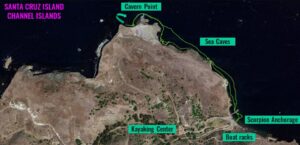
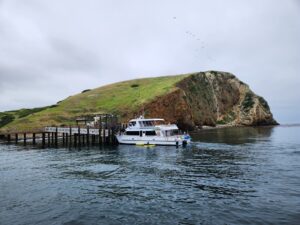
Take the Ferry
From Ventura, the ferry takes 1.5 hours to cross the Santa Barbara Channel with stops for viewing wildlife. It’s chilly on the top deck so bring a jacket and a hat. Once you pass the oil rigs, the bottom of the sea floor drops off a cliff. In the deep water, this is where you might spot large marine mammals. Sure enough, a pod of dolphins surfs the wake trailing the boat. You may also see seals and sea lions bobbing on buoys. You see the outline of Anacapa’s sharp mountain ridge first. Then, you see Santa Cruz’s dark silhouette. The pier can only manage one ship at a time, so we wait in the harbor. We disembark the boat at Scorpion Anchorage and enter a lush green isle with tall cliffs.

Gear up
The Channel Islands Adventure Company kayaking center is 1,000 feet from the pier. There are shipping containers filled with gear, storage boxes, and changing sheds.
The first order of business is to gear up. Grab a wetsuit but roll the top down at the waist. It’s for keeping your legs warm. The splash jacket is a nylon sweater for keeping you dry. You’ll be moving so you don’t need the warmth. Tie it around your waist as well. Clip and zip up your personal flotation device. Wear the helmet since there can be rock fall in the caves and the ceiling is low in some spots. Water shoes are a bonus.
Beach Launch
From the rocky beach next to Scorpion Anchorage, we launch our kayaks into the harbor. Remember to place your butt in the seat, plant your feet down, and position your back against the seat pad. An easy way to remember this is – Butt – Feet – Back. We go under the pier between the narrow space between the black insulated pylons. The water is clear and you can see the kelp beneath the boat. The paddles get tangled in the clumps of kelp at the surface.
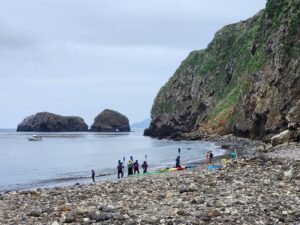
Rocky Coast
Our guide Caco leads us west to the sea caves beneath the tall rocky bluffs. The cliffs look like someone cut a slice from the crumbliest coffee cake ever. The waves have worn away the bottom half of the basalt cliff, revealing multiple little cave openings.
We pass by the Elephant’s Belly. This sea cave has a giant arch that looks like an elephant’s trunk. Paleontologists have found pygmy mammoth fossils on the island. The pygmy mammoth was only six feet tall. Big Columbian mammoths swam to the Channel Islands and over time evolved to be smaller because of limited food supplies.
Before each cave, Caco surveys the conditions, tells us how to run it, and sends us one at a time. We enter the first cave through the left opening then make a hard right to exit the right opening. It’s narrow and really easy to get close to the rocky walls. You have to duck and weave a bit to avoid them. Taking little and vertical strokes helps in confined spaces.
The water by the cliffs is super calm and tranquil. There are no ripples or waves, just nice glassy water.
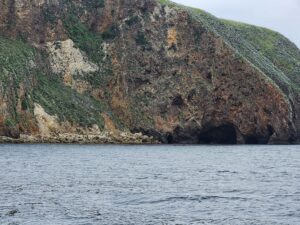
Sea Caves
Harbor Seal Cave is a giant cavern with a wide entrance. We paddle in to this dark space to get a better look. There is a large beach with rocks. We count about six or seven harbor seals resting next to the rocks.
Tiny brine shrimp buzz around the kelp. Mixed in the kelp is a clear rubbery oval with a fingerprint pattern. Each blob is a velella, a relative of coral and jellyfish. Many polyps combine to form rafts with a fin to float with the tides. They usually drift in from remote parts of the ocean during El Niño years.

The second to last cave is medium in size. The plan is to go in a narrow low opening at the left. Avoid the sloping wall on the left and rock on the right. Make a hard right to exit.
In between each cave, there are bumpy pedestals with resting birds.
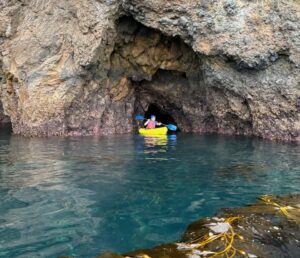
The Longest Cave
The last cave was dim and about 300 feet to the end. In the long tunnel, immediately to the left is the narrowest darkest grotto. I am too eager to go, so I follow Caco before he has finished surveying it. We all have to back paddle to give him some space. We wait for the other group to leave through the main chamber. Caco decides we’ll run the length of the main chamber to the end and then exit through a narrow route.
When we reach the end, Caco turns off his flashlight. We sit in the dark for some moments enjoying the space and peering at the light from the entrance. We turn into another tunnel to exit. It’s narrow and even darker. Near the end, the ceiling is flat and low. This is where we have to lean back in order to get through. I’m glad my helmet is preventing the rocks from bashing my face in.
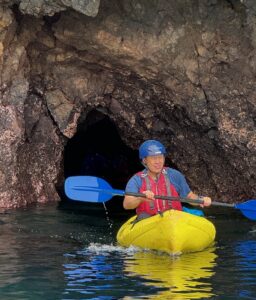
Running Elephant’s Belly
We turn back for Scorpion Anchorage just after Cavern Point. There is one last obstacle. We are running Elephant’s Belly’s trunk-shaped arch. It’s not a straight shot, but more of an S curve. Use your paddle as a left rudder to spin past a rock. Then, by the end, make a right rudder to spin left. There was a big starfish, but no one saw it. We were too busy navigating the kayaks.
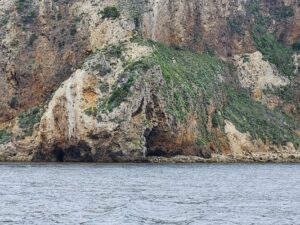
Kayaking Tips
- Keep your shoulders centered to prevent the kayak from rolling over. Your hips can move from side to side as long as your shoulders are centered.
- Plant your feet and push back against the start for better leverage and power for each stroke.
- Bend your knees just enough without blocking the paddle.
Plan Your Visit
| Vendor: Book both the ferry and kayaking trip from Santa Barbara Adventure Company:
Schedule:
|
Equipment
Provided Gear:
What to Bring:
|
Keep Kayaking!
If you are looking for other epic kayaking adventures, check out the following.